History of the Office of the President
The first residence: Weizmann House in Rehovot (1948-1952)
Dr. Chaim and Dr. Vera Weizmann’s private residence was built in 1934 on the outskirts of the city of Rehovot. Their large house was designed by the architect Erich Mendelsohn, incorporating a special fusion of modernist architecture with Mediterranean influences. The house would soon become a well-known architectural icon, which was known as Villa Weizmann and even Weizmann Palace. When Chaim Weizmann was elected the first president of Israel, his private home also became his official residence. The Weizmanns assumed the task of transforming their home into an official institution, giving it an appropriately dignified demeanor, and thus their house became one of the earliest symbols of the sovereignty of the young State of Israel.
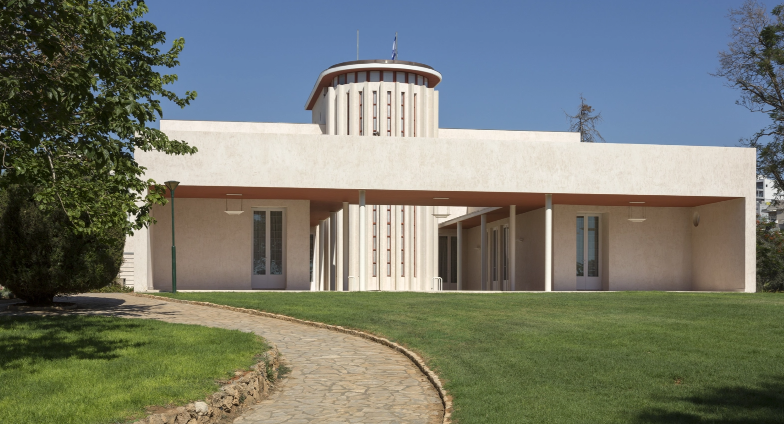
Weizmann House
Credit: Mikaela Burstow
President Weizmann and his wife Vera opened their home to the Israeli people, to which ordinary citizens, military officers, politicians, and high-ranking foreign guests regularly made pilgrimage. The tradition of the President’s Residence as the “People’s House” is in effect a direct continuation of the policy instituted by the Weizmanns. Upon Chaim Weizmann’s death, he bequeathed his house to the Weizmann Institute, and it now functions as a museum commemorating his legacy. President Chaim Weizmann and First Lady Vera Weizmann’s gravesite lies nearby.
The President’s Residence moves to Rehavia in Jerusalem (1952-1972): The Presidential Cabin
With Yitzhak Ben-Zvi’s election as president, the president’s official residence moved to Jerusalem. Ben-Zvi, who lived with his wife Rachel Yanait in a cabin in the Meshek HaPoalot area of Rehavia, wished to adhere to his modest lifestyle as president and refused to move into any of the stone houses offered to him by the government. In the end, the state purchased the nearby Villa Valero next to Meshek HaPoalot and built two wooden cabins in the garden (they were popularly nicknamed “Swedish huts”). The former Valero family house served the presidential couple as their residence, and the cabins served President Ben-Zvi, and after him, the Third President, Zalman Shazar, for receptions and events.
The simple cabins perfectly matched the characteristic modesty of the Ben-Zvi couple, who were careful not to raise themselves above the people in their lifestyles. Nowadays, the compound, including both the Valero house and the Swedish huts, serves the Yad Ben-Zvi research institute.
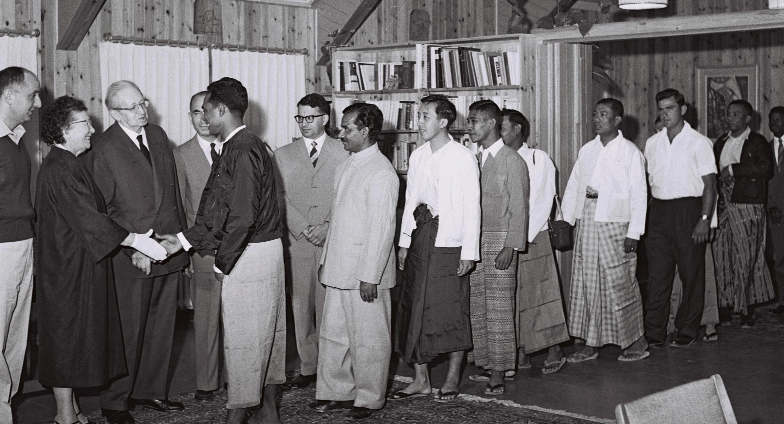
The Presidential Cabin
Credit: Moshe Pridan, GPO
The President’s Residence moves to its current site in the Talbiya/Komemiyut neighborhood of Jerusalem (1972—present)
The current Israeli presidential residence was built during the term of Zalman Shazar, the Third President of the State of Israel. Shazar insisted that the President’s Residence not be built in the Government Complex (Kiryat Hamemshala) under construction at the time, but rather in a residential neighborhood in the center of Jerusalem, quoting the biblical verse: “I live among my own people.” After an examination of the existing options, a site was selected for the construction of the President’s Residence: a 2.5-acre plot on a hill in the Komemiyut (Talbiya) neighborhood. The hill, which was high but not too high, was chosen deliberately to symbolize the President’s status: an elected leader, but not above the people. The residence was inaugurated on Israel’s 24th Independence Day, and all Israeli presidents since have lived and worked there.

The President’s Residence under construction
Credit: Fritz Cohen, GPO
Construction
In 1964, the Government of Israel announced a public competition for the design of the President’s Residence, which was open only to Israeli architects. Forty-seven proposals were submitted to the special committee established for this purpose and headed by Teddy Kollek, the director-general of the Prime Minister’s Office and a future mayor of Jerusalem. The aspiration guiding the committee’s members was to build a house that would be modest and simple yet suitably designed for the president to perform all his functions, and to keep the design faithful to the institution of the Presidency as an Israeli national symbol.
The committee chose the proposal by Abba Elhanani (1918-2008), one of Israel’s preeminent architects.
The residence, construction of which began after the Six-Day War and ended in 1972, was built from local materials, including granite slabs from Eilat and blocks of Jerusalem stone, which were incorporated into the surrounding wall. The design also made use of exposed concrete, which was typical of Israeli architecture in the 1960s and 1970s. The rectangular roof is covered with flat white domes, a tribute to the domes of the Old City of Jerusalem.
In the vision behind Elhanani’s design, the President would live in a house that was also a museum, and instead of having an opulent façade, the building’s splendor would reveal itself inside. As part of this vision, the wings of the President’s Residence are adorned with a variety of works of art.
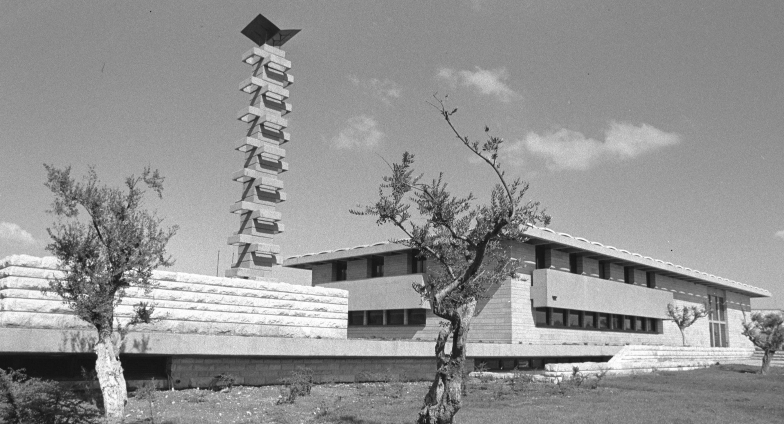
The President’s Residence
Credit: Fritz Cohen, GPO
The structure of the President’s Residence
The President’s Residence contains three wings:
- The Ceremonial Wing contains the Great Hall, where receptions, events, judicial swearing-in ceremonies for judges, and ambassadorial credentials ceremonies are held; it also contains the Jerusalem Room (the “Audience Room”), where the President holds meetings with guests and visitors.
- The Office Wing contains the President’s Bureau and the First Lady’s Bureau, in addition to the offices of the staff of the Office of the President.
- The Residential Wing contains the presidential couple’s private apartment.
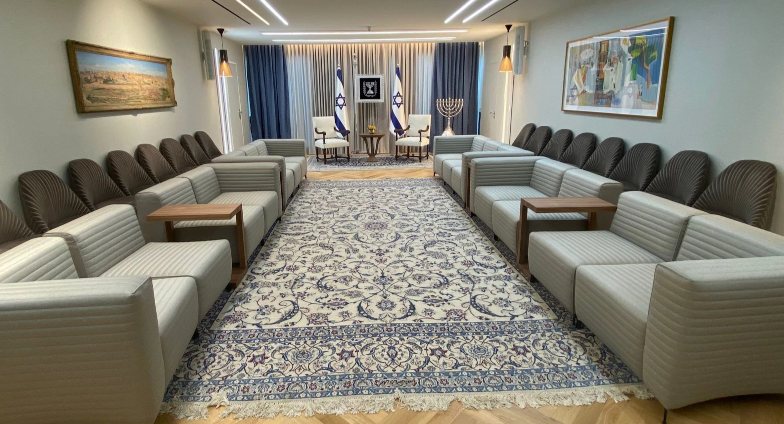
The Main Hall at the President’s Residence
Credit: The President’s Spokesperson’s Office
The President’s Residence Gardens
The three wings of the President’s Residence are surrounded by the Gardens, which contain artistic sculptures, archaeological treasures, and seating areas.
The greenery in the Gardens represents the local flora of the Land of Israel, with fig, pomegranate, cypress, and pine trees, representing the Judean foothills and mountains; cedar trees, representing the Upper Galilee; citron trees, representing the Sharon plain; and a diverse assortment of herbs and flowers. The Gardens also feature dozens of ancient olive trees brought over from the Judean mountains, at the initiative of First Lady Nina Katzir, the wife of the Fourth President, Ephraim Katzir. Katzir’s presidency began shortly before the outbreak of the Yom Kippur War and ended with the start of the peace process with Egypt, and the olive trees were planted as a symbol of hope for peace. Every year, the President’s Residence holds its traditional olive harvest, and sometimes the President gives bottles of oil pressed from the olives as gifts.
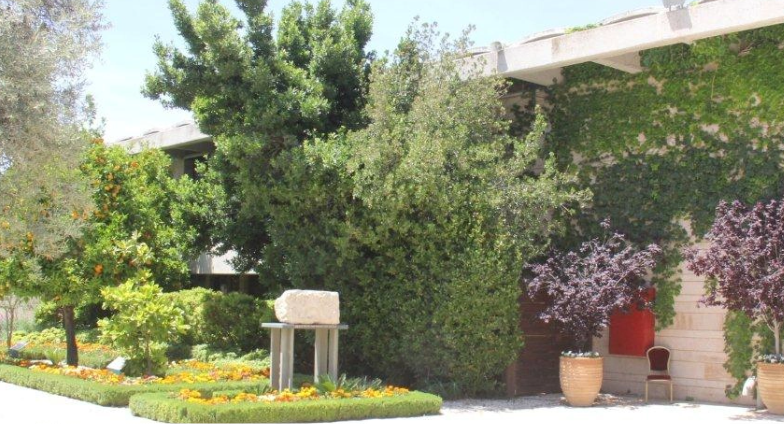
The President’s Residence Gardens
Credit: Igal Slavin
The President’s Residence Gardens hosts festive events, such as the traditional public reception in the President’s Sukkah during the Jewish holiday of Sukkot and an Iftar dinner during the Muslim holiday of Ramadan. The Gardens also host ceremonies with large audiences, such as the ceremony saluting 120 outstanding soldiers on the morning of Independence Day, the presentation of the President’s Award for Outstanding Reserves Units, the Israel Defense Prize ceremony, and the Presidential Award for Volunteerism prizegiving ceremony. The Gardens are also where honor guards are held for ambassadors presenting their letters of credence.
One of the most recognizable sections of the President’s Residence Gardens is the row of busts of former presidents. Traditionally, each president is entitled to select his own artist to memorialize his image in sculpture form and to be involved in the style and design of his bust. The busts are therefore not uniform in their sizes and styles, and in this respect, to a large extent, they reflect the freedom given to each president to shape his term in office as he sees fit.
The Synagogue was inaugurated in the President’s Residence Gardens in 2001, and it is used on weekdays for prayer services by local residents. Several Israeli presidents over the years, including President Isaac Herzog, have made it a habit to join these services.
In 2002, the Archaeological Gardens were inaugurated at the President’s Residence, featuring a diverse collection of historical treasures from around the Land of Israel, on loan from the Israel Antiquities Authority, including a Herodian stone from the walls of the Temple Mount, proto-Aeolic limestone column heads, a mosaic floor from Byzantine-era Caesarea, and more.
Art at the President’s Residence
In accordance with Abba Elhanani’s vision for the President’s Residence as a museum to celebrate Israeli art, the President’s Residence contains an extensive collection of artworks, some temporary and others permanent, which lend the residence a sense of splendor, richness, and cultural transcendence. Most of the artworks are displayed in the Great Hall, which is visited by tens of thousands of people every year. In order to keep the exhibition contemporary and fresh in in line with modern artistic styles, First Lady Michal Herzog has appointed a professional committee to advise her on these issues.
The Shraga Weil Doorway
At the entrance to the Great Hall stands a momentous, two-story-high doorway designed by the artist Shraga Weil (1918-2009). Weil was a member of the Hungarian underground during the Second World War, and when he made aliyah, he became a member of Kibbutz HaOgen. He was a multidisciplinary artist—a sculptor, illustrator, and painter—and one of his signature works is the official Doorway of the President’s Residence.
The Doorway at the entrance of the Great Hall was designed in a modern style, paying tribute to ancient Near Eastern art. Its exterior is made of bronze, with Jewish symbols such as the lion of Judah, the Menorah, and doves of peace cast into the doors. The interior panels are made of oak, adorned with a sun-shaped tableau next to the words “put some of thine honor upon him” (Numbers 27:20).
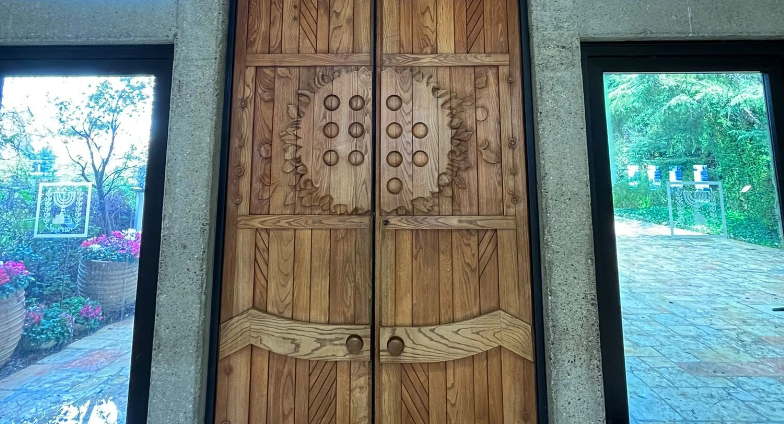
The Shraga Weil Doorway
Credit: The President’s Spokesperson’s Office
The Naftali Bezem Ceiling Mural
The impressive and colorful ceiling of the Great Hall at the President’s Residence was designed by the artist Naftali Bezem (1924-2018). Bezem, who was born in Germany and made aliyah with the outbreak of the Second World War and was deeply involved in commemorating the Holocaust through art, studied at the Bezalel Academy of Arts and Design and worked with numerous art forms. Among his many works is the From Holocaust to Rebirth relief at the Yad Vashem Museum in Jerusalem.
Bezem’s ceiling comprises 63 ceiling panels (acrylic on asbestos), which tell the story of his journey to the Land of Israel in a manner emphasizing the transition from the Holocaust to Israel’s national rebirth, from exile to redemption. Among the elements appearing in Bezem’s artwork are:
- Shabbat candles, which appear twice; in the section representing the exile, they are extinguished; in the rebuilt Jerusalem, on the head of the lion of Judah, they are lit up and radiate light;
- A ship sailing toward the Holy Land, with a hoe, pitchfork, shofar, and wheel as its oars;
- A ladder, symbolizing aliyah and redemption and recalling Jacob’s ladder, which ascended to the heavens;
- The roots of the ladder poke through to distant layers of earth, covered in piles of ancient, fractured stones; the stones are arranged as an altar, creating a walled enclosure protecting the Old City.
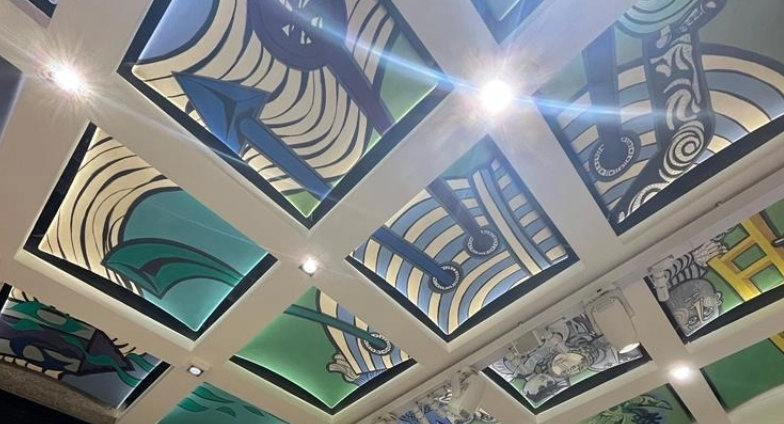
The Naftali Bezem Ceiling Mural
Credit: The President’s Spokesperson’s Office
The Reuven Rubin Stained Glass Windows
The series of three vibrantly colored stained glass windows, 20-feet tall, adds splendor to the Great Hall. This masterpiece is the work of one of Israel’s most preeminent artists, Reuven Rubin (1893-1974), who was born in Romania. The glass artworks are formed as a triptych: the window on the right depicts the Prophet Elijah ascending to the heavens in a chariot of fire, while the Prophet Elisha remains on earth; the middle window depicts King David playing his lyre at the bottom of Jerusalem’s walls, with a verse from Psalms: “Our feet shall stand within thy gates, O Jerusalem”; and the leftmost window depicts Jacob wrestling with the angel, with a verse from Genesis: “Your name shall no longer be Jacob, but Israel.”
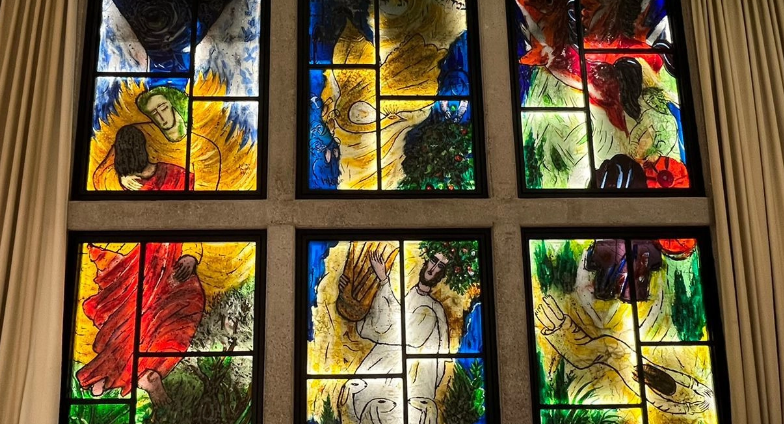
The Reuven Rubin Stained Glass Windows
Credit: The President’s Spokesperson’s Office
The Wall of Praise to Jerusalem and Gold Scroll, Moshe Castel
On the southern and northern walls of the Great Hall, respectively, stand two artworks by Moshe Castel: the Wall of Praise to Jerusalem, one of the most recognizable features of the President’s Residence and the background for the traditional photograph of each incoming government; and the Gold Scroll relief.
Castel (1909-1991), born in Jerusalem to a family who arrived in the Land of Israel after the expulsion from Spain, studied at the Bezalel Academy of Arts and Design, was one of the founders of the New Horizons group of artists, and produced wall reliefs for several places across the country, including the Knesset building, the Churchill Auditorium at the Technion Institute, the Dan Accadia Herzliya Hotel, and more.
The artworks that Castel produced for the President’s Residence are made of crushed basalt stone, cast into reliefs. The Wall of Praise to Jerusalem is a clear allusion to the Western Wall. It is 18 feet wide by 16.5 feet tall and features monumental stones of different sizes and shapes. In front of this wall, Castel added twelve characters—the number of Tribes of Israel—with biblical-looking figures symbolizing the pilgrimages to Jerusalem and the Temple.
The Gold Scroll relief appears on the northern wall of the Great Hall. The centerpiece, 16.5 feet tall by 6.5 feet wide, is a single large scroll, complemented by four more small scrolls, adorned with Paleo-Hebrew letters, lending them the appearance of ancient scrolls that have worn out with time, in a manner reminiscent of the Dead Sea Scrolls discovered in the Judean Desert.
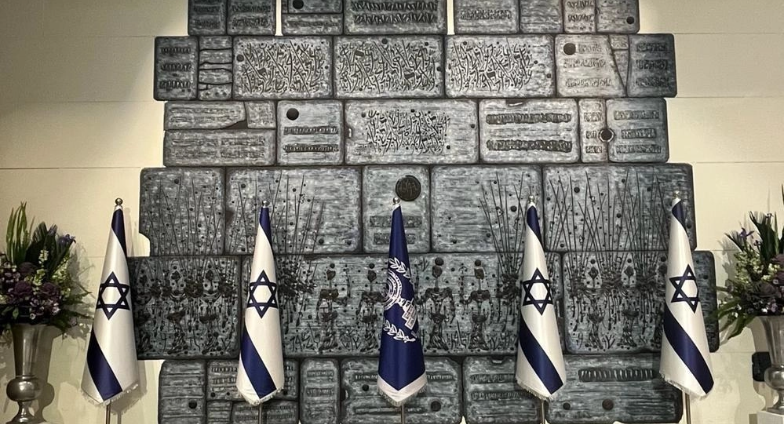
The Wall of Praise to Jerusalem and Gold Scroll, Moshe Castel
Credit: The President’s Spokesperson’s Office
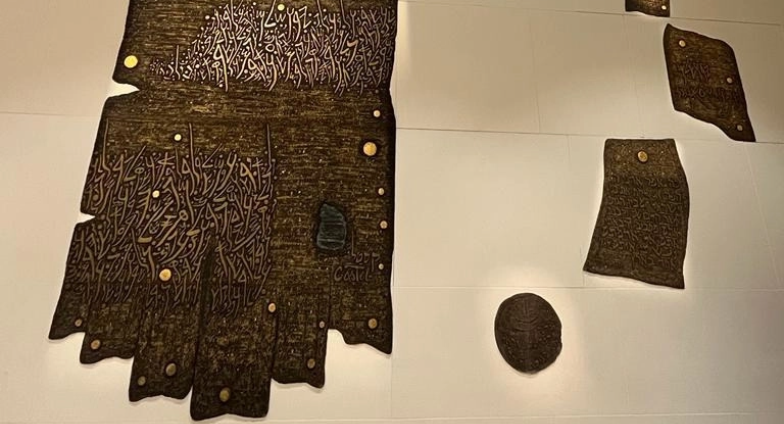
The Golden Scroll – Moshe Castel
Credit: The President’s Spokesperson’s Office
Book a Tour
Visiting the President’s Residence is free of charge!
Visits must be booked in advance. You may sign up for a 90-minute visit and tour (including the security check) in Hebrew, Arabic, or English.
Please note: You may only visit the President’s Residence through an organized tour. The President’s Residence is a living and active institution, with a tight timetable that is always subject to change. We advise booking a tour at least a month or two in advance. There is a possibility that before your visit, we will have to postpone or cancel your tour owing to other engagements at the President’s Residence.
- Entry to the President’s Residence is subject to a security check.
- No weapons allowed.
- You are advised not to arrive with bags or laptops.
- Entry is subject to the presentation of ID.
- Please wear appropriate and respectful clothing.
- In order to protect the environment, the President’s Residence avoids using disposable utensils. Please come with your own water bottle, which you may fill here.
- Tours for organized groups (over 15 participants): Organized groups, charities, companies, schools, public sector workers, soldiers, units in the security forces, and family groups with over 15 people are invited to book a tour here.
- Tours for adults (under 15 people): Individual visitors or groups with fewer than 15 participants are invited to book a tour here.
Organized group tours (more than 15 PAX)
Organized groups, non-profits, corporations, schools, state employees, soldiers, defense personnel units, family groups larger than 15 participants can schedule a tour here.
Organized Tours for Adults (less than 15 PAX)
Single Visitors or groups numbering less than 15 participants may schedule their tour here.
Tours for families and children
The President’s Residence is also open to children and invites the next generation of the State of Israel to enjoy a unique experience and discover the institution of the Presidency! You can sign up for family tours, tailored for children up to the age of 15, here.
Workshops for organized groups
How do I get to the President’s Residence?
The President’s Residence, 3 Hanasi Street, Jerusalem.
The President’s Residence is served by Egged bus route 13 at the Beit Hanasi bus stop.
You may also walk to the President’s Residence from the following bus stops:
Azza/Radak (~5 minutes). Buses: 9, 17, 19, 19a, 22, 92, 517, 791.
Keren Hayesod/Ahad Ha’am (~10 minutes). Buses: 7, 7a, 18, 34, 34a, 71, 72, 74, 75, 77, 77a, 78, 78a.
You may also park at the (paid) public parking lot at the Jerusalem Theater, at 1 Prof. Ya’akov Sheskin Street (~7-minute walk).



